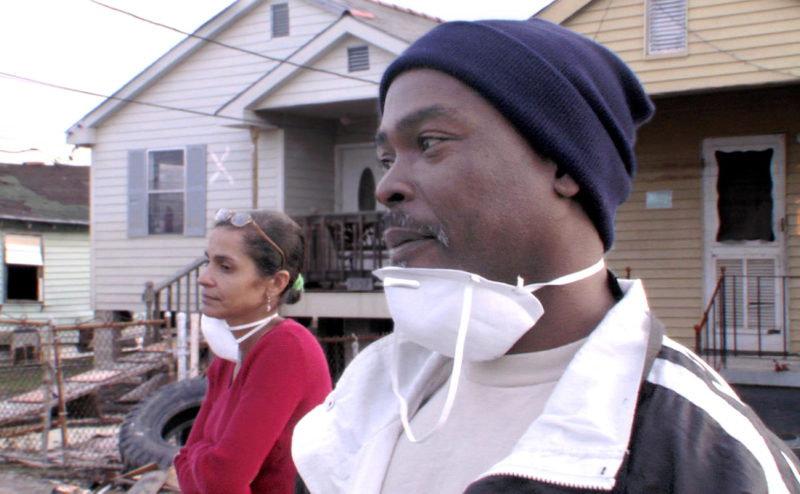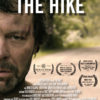
Never-Ending Storm
Written by Lynn Tryba | Posted by: NewEnglandFilm.com
The Axe in the Attic opens six months after Katrina hit and the levees breached and flooded New Orleans. During their 60-day road trip down South, New England filmmakers Lucia Small and Ed Pincus interviewed evacuees living in FEMA trailers or with relatives in new cities. No talking heads or experts appear in the film. Each survivor simply looks at the camera and talks plainly about their losses.
The footage captures people’s struggle to adjust to a life filled with bureaucratic red tape and donated clothes. It shows them cherishing moldy family photos — the only salvageable items from their ruined homes. The subjects speak longingly of the simple things they miss: a job to go to, children playing in the street, privacy, a place of their own. They persevere in spite of their bewilderment and grief. They’ve lost their entire lives in one day and want to know what the word “closure” means. They wonder who has the time to read government brochures advising people on how to cope when everyone is too stressed out to sit down and read them.
This resilience, anger, and humor comes through in The Axe in the Attic, produced by Pincus & Small Films, which launches the Human Rights Watch International Film Festival at the Museum of Fine Arts Boston on January 16th.
Although the documentary has yet to receive distribution, Small envisions it playing in the cities that took in the evacuees and being a vehicle to prompt discussion and build outreach.
The Axe in the Attic premiered last October at the prestigious New York Film Festival, but created some controversy because of a risk Pincus and Small took with the project — mainly, that they included themselves in the film. Not a lot. Just enough to acknowledge they were approaching the subject of the Katrina diaspora as two white Northerners with their own perspectives, viewpoints that informed their filmmaking choices at every turn. Through the ethical dilemmas and debates captured on film — should they give money to people in need, for example — the filmmakers stand in as surrogates, expressing the angst that many Americans felt in Katrina’s wake. They embody the desire to help, the confusion over how to do so, and the awareness that some forms of aid are bandages over a systemic problem rooted in issues of race and class. Likewise, as surrogates, they sometimes receive the brunt of the evacuees’ anger, which is borne out of a sense of abandonment by the government, its agencies, and the American people as a whole.
The decision to include themselves in the film was made warily, Small admits. “We struggled a lot with that decision. In test screenings, 10 to 20 percent of audiences really didn’t like our presence.”
People misunderstood their motives for including themselves in the film, thinking they were trying to compare their problems during filming with what the Katrina survivors went through, Small says.
“That wasn’t our intent at all,” she says. “We were purposely showing our foibles and missteps.”
At one point, the filmmakers are confronted by local activists helping residents rebuild. They want Small and Pincus to add a clause to their release form stating that interview subjects will be paid a percentage of the profit if the film makes any. They want them to pay the elderly couple they’re interviewing $5 upfront for their time.
Small understands where the activists were coming from. There was a sense at the time that there was carpetbagging going on, she explains. Outsiders were coming down and making money by taking photos of people’s devastation. “It’s a fine line,” she says.
Ninety-five percent of the people she and Pincus interviewed thanked them for letting them talk about their experience, she says. “In my films I always want to provide a voice to those who don’t always have a voice.”
One evacuee asks how George Bush, the most powerful man in the world, could not know about the faulty levee system. He asks the filmmakers: He’s killing people in seven continents and he doesn’t know what’s going on in his own country?
A white Vietnam Vet cries as he relates how white FEMA workers made racist remarks to him, thinking he would be in agreement because of their shared skin color.
A young African American woman describes how she saw a mother drop her baby off a bridge while National Guardsmen stood by and did nothing.
A man talks wonderingly about how National Guardsmen pointed their weapons at him and others who were hungry and needing help, as if they had done something wrong.
It took Small (co-producer, co-director, and editor) more than a year to pare down 175 hours of footage to 110 minutes. “I was watching those images 12, sometimes 14 hours a day. They impacted me a lot. I still think of some of those images and about what the subjects are up to.”
One of the biggest editing challenges was letting go of subjects who were interesting but did not fit into the structure of the story. “Many of them could have been their own film. It was a struggle on the road [to leave them behind] and it was a struggle in the editing room,” Small says.
It is not surprising that there is a self-reflexive element to The Axe in the Attic. Pincus has been called the grandfather of autobiographical filmmaking. In 1981, he released Diaries: 1971-1976, which documented his life during the beginning of the Women’s Liberation Movement. Small found festival success and distribution with her 2002 documentary, My Father, The Genius. The film examines the personal and professional successes and failures of her architect father, and includes interviews with her family.
The two filmmakers met a few years ago while serving on a film panel and formed their company in 2005. “My Father, The Genius was my connection to Ed’s form of filmmaking,” Small says.
She found the creative collaboration with Pincus (co-producer, co-director, and director of photography) very rewarding. “It was like we’d been working for years together,” she says.
Unfortunately, the film did not meet its budget goals, and the two filmmakers are now dissolving their company. Small’s company, Small Angst Films, will be handling the distribution efforts of The Axe in the Attic. To that end, Small recently left her beloved Boston film community to move to New York, where she says there is more money, more industry, and more deals to be made. In addition to maintaining momentum around The Axe in the Attic, Small has three projects on tap.
She is hoping to produce another film about her father, Glen Small. Since finishing My Father, The Genius, she has shot more than 40 hours of new footage. In 2003 and 2004, she and DP Allie Humenuk (In the Shadow of the House) went to Nicaragua to film him in the process of building some large government buildings. Now, he has another international project brewing in the Middle East — it’s green — and a realization of his life-long dream.
War Stories is in preproduction. This film will explore the long-term consequences of post-traumatic stress disorder suffered by a veteran returning from Iraq, told through the eyes of the soldier’s family. It will combine documentary elements with narrative fiction.
Small’s third project may be a commercial piece she’s not yet ready to share details about, but it promises to be juicy, thought-provoking, and timely.
For the next six to eight months, though, much of her time and heart will be devoted to getting The Axe in the Attic — and the people in it — the attention they deserve.
The Axe in the Attic screens six times at the MFA, Boston January 16-31. A discussion with the directors follows the January 16th screening. For more information, visit www.theaxeintheattic.com.
The Axe in the Attic screens six times at the MFA, Boston January 16-31. A discussion with the directors follows the January 16th screening. For more information, visit www.theaxeintheattic.com.











